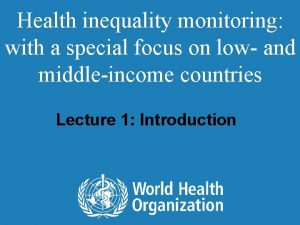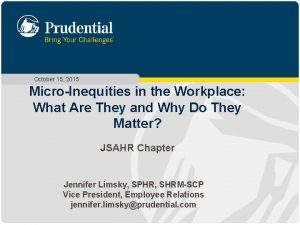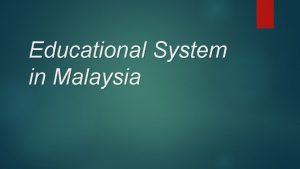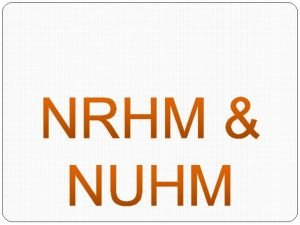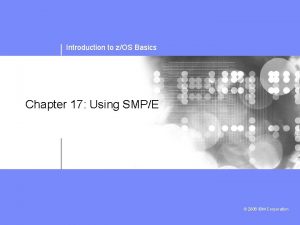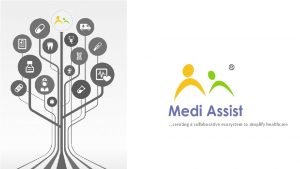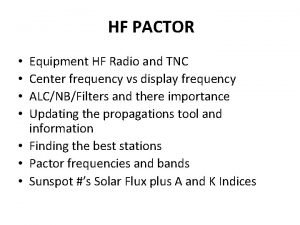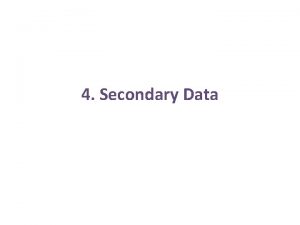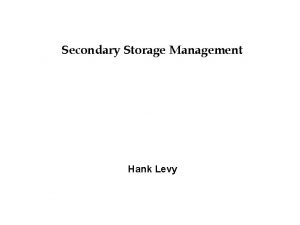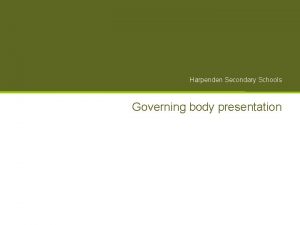Inequities in Tracking in Secondary Schools Kristyna Looney

















- Slides: 17

Inequities in Tracking in Secondary Schools Kristyna Looney, Hui Xu, Laura Lewis, & Cat Jackson

What to Expect • • • Definitions of Key Terms Inequity in Tracking Problems and Issues Educational Technology Inequity Critical Review and Analysis Summary of Significant Issues and Conclusions

Key Terms • Tracking is defined as “broad, programmatic divisions that separate students for all academic subjects” (p. 1) while ability grouping refers “to divisions among students for particular subjects, such as special class assignments for math or within-class groups for reading” (p. 1). (Gamoran, 1992)

Key Terms • Tracking • Instructional Strategy The techniques or methods that a teacher uses for meeting various learning objectives such as maintaining attention, deepening understanding, and/or encouraging effective learning.

Inequity in Ability Grouping Within-school sorting creates “inequities in access to high quality teachers as well as high-performing peers” (Kalogrides & Loeb, p. 311) • • Black, Hispanic, and poor students more likely to have novice teachers • This sorting “likely has negative consequences for equity (Kalogrides & Loeb, p. 314) • Peer effects must be considered • Lower ability students may gain through interaction in a heterogenous classroom (Hanushek & Woessmann, 2006)

Inequity in Ability Grouping Variances in different ability groups/tracked classes • Classroom pacing • Context and climate • Curriculum changes (worksheets vs. discussion) • Unequal behavior and attitudes among students (Gamoran, 1992)

Inequity in Access • Limited number of AP or advanced type courses. (Gagnon & Mattingly, 2016; Hallett & Venegas, 2011; Solorzano & Ornellas, 2004; Yonezawa, Wells, & Serena, 2002) • Major concern: Larger proportion of minorities living in poverty (National Poverty Center, 2015; Farinde, Adams, and Lewis 2014) • Even when AP or advanced courses offered, minority students are hindered by institutional barriers (Yonezawa, Wells, and Serna 2002)

Inequity in Instruction • More likely to be taught by a novice teacher (Kalogrides and Loeb, 2013; Milner, 2013: Aragon et al. 2014), • Taught more at the transmissive learning rather than transformative learning (Yonewzawa, Wells, & Serna, 2002: Milner 2013). • View of Behavior perceived differently (Milner 2013)

Problems and Issues • Instructional differences among schools due to socioeconomic status transcends all levels of courses. Rural vs urban • Teachers and instructional strategies: a novice, untrained teacher vs higher socioeconomic schools teach students to engage in “more deeply complex activities” and “critical thinking • Tracked aspirations aspect: Gender, parental influence, peer group, and culture are part of this track aspiration • Choosing respect aspect: Students of any race want to feel welcomed and respected and want to be part of a circle of friends.

Educational Technology • Benefits of Technology in the Classroom • Intended and unintended consequences of educational technology on social inequality (Tawfik, Reeves & Stich, 2016) • Mobile (tablet) technology • Problems of the Digital Divide • Digital Literacy • Disparities in AP classes • Professional Development Issues

Critical Review and Analysis • Homogenous classrooms allow for focused curriculum and appropriately paced instruction • Looking at over one hundred years of research, students benefited, to a small degree, from withinclass, cross-grade subject, and special grouping for the gifted • Gifted students benefited greatly (Steenbergen-Hu, Makel, & Olszewski-Kubilius, 2016)

Critical Review and Analysis • Grouping leads to continuing bias against disadvantaged students • Preparation on entry into school related to socioeconomic background (Hanushek & Woessmann, 2006) • Do the benefits outweigh the bias against disadvantaged students?

Critical Review and Analysis • Educational Policies • National Educational Technology Plan • Connect. Home • BYOD issues • Impact on Teachers’ Instructional Strategies • Increase in language and culture diversity in our schools. • More likely to be transmissive education.

Critical Review and Analysis • Impact on Teachers’ Classroom Discourse • Minority students do not feel capable to contribute and their comments are not valued nor respected (Yonezawa, Wells & Serna, 2002) • • • Minority students are lacking the skills expected because of the lack of quality teachers (Kalogrides & Loeb, 2013; Milner, 2003) High tracked classes taught to critically think and problem solve. Low tracked classes taught to follow rules and status quo.

Summary • • Student Tracking Inequity Educational Technology Support Quality of Instruction and Instructional Strategies Stakeholders

Citations Aragon, A. , Culpepper, S. A. , Mc. Kee, M. W. , & Perkins, M. (2014). Understanding profiles of pre-service teachers with different levels of commitment to teaching in urban schools. Urban Education, 49(5), 543 -573. doi: 10. 1177/0042085913481361 Farinde, A. A. , Adams, T. , & Lewis, C. W. (2014). Segregation revisited: The racial education landscape of Charlotte Mecklenburg Schools. Western Journal of Black Studies, 38(1), 177 -183. Gagnon, D. & Mattingly, M. J. (2016). Advanced Placement and rural schools: Access, success, and exploring alternatives. Journal of Advanced Academics, 27(4), 266 -284. doi: 10. 1177/1932202 X 16656390 Hallett, R. & Venagas, K. M. (2011). Is increased access enough? Advanced Placement courses, quality, and success in low-income urban schools. Journal for the Education of the Gifted, 34(3), 468 -487. Hanushek, E. A. , Woessmann, L. (2006). Does educational tracking affect performance and inequality? Differences‐in‐differences evidence across countries. The Economic Journal, 116(510), C 63 C 76. Kalogrides, D. , & Loeb, S. (2013). Different teachers, different peers: The magnitude of student sorting within schools. Educational Researcher, 42(6), 304– 316. http: //doi. org/10. 3102/0013189 X 13495087 Milner, H. R. (2013). Analyzing poverty, learning, and teaching through a critical race theory lens. Review of Research in Education, 37(1), 1 -53.

Citations National Poverty Center. (2014). Poverty facts. Retrieved from http: //npc. umich. edu/poverty/ on November 21, 2016. Oakes, J. (1985). Keeping track: How schools structure inequality. New Haven, CT: Yale University Press. Oakes, J. (1990). Multiplying inequalities: The effects of race, social class, and tracking on opportunities to learn mathematics and science. Santa Monica: RAND. Tawfik, A. A. , Reeves, T. D. , Stich, A. (2016). Intended and unintended consequences of educational technology on social inequality. Tech. Trends, 60(6)598 -605 doi: 10. 1007/s 11528 -016 -0109 -5 Schafer, W. E. , and Olexa, C. (1971). Tracking and opportunity: The locking-out process and beyond. Chandler Pub. Co. . Steenbergen-Hu, S. , Makel, M. C. , & Olszewski-Kubilius, P. (2016). What One Hundred Years of Research Says About the Effects of Ability Grouping and Acceleration on K– 12 Students’ Academic Achievement Findings of Two Second-Order Meta-Analyses. Review of Educational Research, 86(4), 849 -899. Solorzano, D. & Ornelas, A. (2004). A critical race analytsis of Latina/o’s and African American Placement enrollment in public high schools. The high School Journal, 87(3), 15 -26. doi: 10. 1353/hsj. 2004. 003 Yonezawa, S. , Wells, A. S. , & Serna, I. (2002). Choosing tracks: “Freedom of choice” in detracting schools. American Educational Research Journal, 39(1), 37 -67.
 Inequities vs inequalities
Inequities vs inequalities Micro inequities in the workplace
Micro inequities in the workplace Kristýna pavlů
Kristýna pavlů Caroline looney
Caroline looney Kytc standard specifications
Kytc standard specifications Looney tunes speech disorders
Looney tunes speech disorders Jigaloe
Jigaloe Huntsville cs powerschool
Huntsville cs powerschool Safety reach and target schools
Safety reach and target schools Aims of teaching economics at higher secondary level
Aims of teaching economics at higher secondary level Level of education in malaysia
Level of education in malaysia Mother and child tracking system
Mother and child tracking system Top ten risk item tracking
Top ten risk item tracking Lesson 4 tracking your expenses
Lesson 4 tracking your expenses Smppts
Smppts Dahabshiil tracking
Dahabshiil tracking Medibuddy username
Medibuddy username Pactor tnc
Pactor tnc
